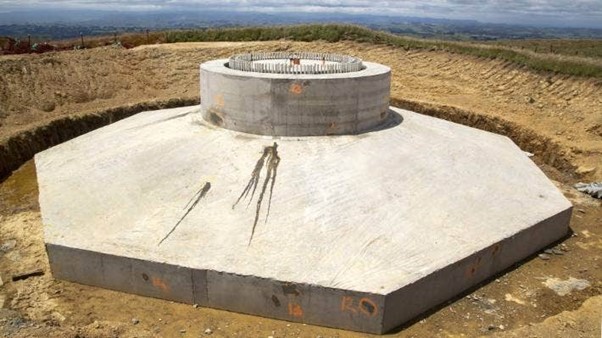
Richard Lilley is a retired solicitor who lives in the Upper Worth valley.
Turbine 6: Shackleton Knoll SD 98539 31512 ///incorrect.diverting.steered

Go, sit upon a mountain steep,
And view the prospect round;
The hills and vales, the valley’s sweep,
The far horizon bound.
And as you gaze on this vast scene
Your thoughts will journey far,
Though hundred years should roll between
On Time’s swift-passing car.
From ‘Or Else Not, Say I’ by Charlotte Bronte
—————————————————————————————————
“I want to call it The Ascent of T6.”
“Enviable title”, says Mr MacKinnon, kindly, of this nod to Auden and Isherwood’s unperformable verse drama “The Ascent of F6”. A day for walking with poets in defence of the landscape.
As near-death experiences go, being driven anywhere by Nick is up there with ayahuasca. He navigates the road like a one-eyed man distracted by a cryptic crossword; and to add to the sense of adventure is fresh returned from a California road trip and possibly jet-lagged.
“Oh Jesus!” and he makes a dramatic adjustment to the left as we motor down Dean Edge Road. “I’m still in America.” Surely his insurers didn’t let him drive in America. I am myself a lifetime happy passenger, having concluded as a teenager that the world would be in every way better without my driving in it.
“We are going to Oxenhope.” Nick announces or possibly enquires. All I know about Oxenhope is that it is some kind of suburb of Leeds. The Met Office advise us the weather will be picturesque with “Skies like a Constable landscape”. The closest John Constable ever got to Calderdale Wind Farm was the Lake District in Autumn 1806, which “oppressed his spirits” – another bloody southerner.
Eventually we park at Pecket Well and set off downhill. The Ingenious Gentleman of La Mancha comes to mind as the scale of the endeavour (it will be the longest walk I have done for a decade) manifests itself to me:
“There Sancho Panza my friend those wild giants with whom I intend to do battle and kill each and all of them. For it is wonderfully useful to God to wipe such an evil race from the face of the earth”.
“Now look your Grace. They are not giants but Windmills….”
We stumble down the precipitous path grooved with cut stones like a Roman aqueduct to Lumb Bridge and a cinematic festive scene. Fearless shrieking girls and timid boys plunge into the glacial depths of Lumb Hole supervised by their apprehensive parents “Watch it, our Byron… You’ve been told!”. Ted Hughes set his poem ‘Six Young Men’ here, commemorated by a plaque installed by the Elmet Society. Each of them would be killed in the Great War.
All are trimmed for a Sunday jaunt. I know
That bilberried bank, that thick tree, that black wall,
Which are there yet and not changed. From where these sit
You hear the water of seven streams fall
To the roarer in the bottom, and through all
The leafy valley a rumouring of air go.
Pictured here, their expressions listen yet,
And still that valley has not changed its sound…
Soon we are on the ascent making breathless small talk with diverse groups of returning walkers, their accents variously British, Polish, Urdu, Yan Tan Tethera. A joyous sense of community in our smiles and friendly jokes.
Up and up, where of a sudden the whole landscape is vastly revealed: Stoodley Pike in the distance and the “dark stones” of Heptonstall where the dazzling Sylvia lies under both her controversial patrimonial surnames – Plath Hughes.
The whole landscape
Loomed absolute as the antique world was
Once in its earliest sway of lymph and sap,
Unaltered by eyes…
From ‘Hardcastle Crags’ by Sylvia Plath
Since coming back to live in age in the county in which I was born and raised, I have developed a walk from our new home just north of here. Down across the valley from Dean Edge Road and up, as Birthday Letters describe it, “A mile beyond expectation, into Emily’s private Eden… Where the moor lifted and opened its dark flower” on the “blackened smoulder” of Walshaw Moor. Under “Gamma rays and decomposing starlight” its ever-receding summit is an ageless oceanic vastness. A landscape like no other: as full of verse as of wind and wildlife; where the imagination of poets can still be glimpsed and felt unchanged and unchanging on timeless earth.
Making a new garden where the petrified seabed mudlarks its fossils, we found a proto-oyster furled into the Carboniferous relic of a warm ocean, now entangled with heather roots. Time here is present from long before the Anthropocene as the industrial archaeology of more recent pasts falls into sediment like the dissolving Titanic wreck of Griffe Mill below Stanbury. Looking down the valley from Dean Edge you can trace the line of extinct manufactories where worsted was spun and woven from fleeces, mill race melts and child labour. Men fleeing famine in Ireland hewed and carted these ancient rocks, building first lost railways that fold invisibly into the contours from the gouged high quarries, and then the miraculous landscape art of the reservoirs.

A local historian moonlighting as a cab driver explained to me his theory that a lost Roman road is to be found under this moor, a shortcut to the all-important coast and swift access via the fleet to Gaul and then the sunlit centre of Empire. Is the vanished Legio IX Hispana in fact buried in some hill tribe sacrificial pit near the stones of Alcomden? Who knows? We face something far worse than the limitless ambition of the hard men of Valeria Victrix in immaculate ranks: sixty-five implacable turbines up to two hundred metres high.

I stand for my compulsory author photograph by the former cairn, which may have blown down. The boundless scale is everything up here. Your mind rushes in the space. “Like a circle in a spiral/ Like a wheel within a wheel/Never ending or beginning/On an ever spinning reel” Words that jangle in your head in the windmills of your mind. It is impossible not be angry, furious, ashamed. We are not only capable of poetry, we nuclear monkeys. Acting collectively, we think we have possession of that of which we are the merest but most dangerous part. Our place in nature forgotten when we lift our eyes to the heavens and our visions of the future. Higher than bright Lucifer. Money and megalomania directing our lawyers, engineers, surveyors and consultants to raise another Pharaonic house of a thousand years. Trying greedily to satisfy impossible conflicting objectives: energy needs, and the mitigation of the heat generated by our gluttony.

We walk another fifty metres to find the turbine site in new heather. Here in this ancient landscape they will sink foundation voids to fill with concrete in shape and chemistry that rhyme with our fossil oyster. The American Concrete Foundation say:
“A 5 MW turbine may need an 80-foot diameter reinforced concrete foundation to provide support. Such a foundation will require a volume of concrete in the range of 850 to 900 cubic yards (mass concrete) and take seven to nine hours to complete the on-site concrete placement. As the size of the foundations and placement durations have increased, so do the placement challenges.”
On each of these vast slabs of industrial material formed up here by God knows what feats of engineering and extruded into the ancient landscape, will rise sixty-seven 150-200 metre steel windmills, their blades scything the air making an industrial cacophony. Only the most committed technophile would enjoy being here in the shattered landscape. The Satanic Mill Lords harvesting the energy of flowing water and indentured labour had more taste, restraint and awareness of the environment.
Whatever the Land Registry might say about some offshore web of “tax efficient” ownership, we own this landscape: all of us, in the sense that we hold it in trust for what is to come. What will our posterity inherit when Charlotte’s hundred years have rolled? What will be left of the hand that fed them and the heart that mocked? When the concrete, and steel, the rare earth magnets and radial flux generators have exhausted their utility and maintenance? What will it be like among the decay of their colossal wreck, vast and trunkless in a ruined moor, boundless and bare?

As Shelley also wrote “We the People are many and they are few and we should rise like lions after slumber in unvanquishable number” and stop this appalling, irreversible, barbaric and sacrilegious act.
Readers will be glad to know that the campaign group Stronger Together – Stop Calderdale Windfarm are asking for a commitment from all the candidates in the main political parties to include a pledge on wind farms on peat habitat in their climate and nature policies:
‘If elected as MP, I pledge to support urgent new legislation to amend onshore wind planning regulations in order to ban wind farms on protected peat land in England. If necessary I will help to introduce this legislation as a Private Members’ Bill.‘
+++++++++++++++++++++++++++++++++++++++++++++++++++++++++++

Mick Manning MA RCA is an artist and illustrator who grew up in Haworth.
He is an Honorary Fellow of Bradford College of Art and has work in the public art collection at Cliffe Castle, Keighley. He is the author and joint illustrator of ‘The Brontës: Children of the Moors’. (Watts)
This is the 11th in a series of 65 guest blogs on each of the wind turbines which Richard Bannister plans to have erected on Walshaw Moor. Turbines 5, 11, 27, 34, 35, 43, 47, 54, 58 and 64 have already been described. To see all the blogs – click here.
[registration_form]
There is a simple answer to this issue: Government intervention to establish clear guidelines for where onshore turbines are likely to be acceptable – and grid services to go with it
It may push turbines to less windy places – but flat arable landscapes may be more acceptable in almost every way than planting them in our finest landscapes. And Government should take the lead over issues like RAF radars that turbines could interfere with. Keir Starmer is right to be talking about cutting development time – the same might apply to housing – but it must be through strategic leadership, not cutting environmental protection
Shackleton Knoll is another of my favourite places to just sit quietly and enjoy the view and the silence and I have a copy of Kate Lycett’s beautiful painting of that view as the main feature in my living room. Thinking of its destruction for profit is another example of how our society seems to have its priorities in all the wrong places. Hopefully a successful campaign against this proposal will encourage others to fight for our natural environment.